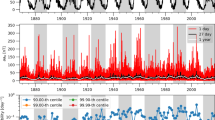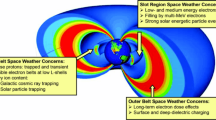Abstract
Energetic electrons are trapped in the Earth’s radiation belts which occupy a toroidal region between 3 and 7 \(\hbox {R}_{\mathrm{E}}\) above the Earth’s surface. Rapid loss of electrons from the radiation belts is known as dropouts. The source and loss mechanisms regulating the radiation belts population are not yet understood entirely, particularly during geomagnetic storm times. Nevertheless, the dominant loss mechanism may require an event based study to be better observed. Utilizing multiple data sources from the year 1997–2007, this study identifies radiation belt electron dropouts which are ultimately triggered when solar wind stream interfaces (SI) arrived at Earth, or when magnetic clouds (MC) arrived. Using superposed epoch analysis (SEA) technique, a synthesis of multiple observations is performed to reveal loss mechanism which might, perhaps, be a major contributor to radiation belt losses under SI and MC driven storms. Results show an abrupt slower decaying precipitation of electron peak (about 3000 counts/sec) on SI arrival within 5.05 \(< L\) < 6.05, which persist till 0.5 day before gradual recovery. This pattern is interpreted as an indication of depleted electrons from bounce lost cone via precipitating mechanism known as relativistic electron microburst. On the other hand, MC shows a pancake precipitating peak extending to lower L (Plasmapause); indicating a combination of electron cyclotron harmonic (ECH) and whistler mode waves as the contributing mechanisms.







Similar content being viewed by others
References
Baker D N, Kanekal S G, Hoxie V C, Henderson M G, Li X, Spence H E, Elkington S R, Friedel R H W, Goldstein J, Hudson M K, Reeves G D, Thorne R M, Kletzing C A and Claudepierre S G 2013 A long-lived relativistic electron storage ring embedded in earth’s outer Van Allen belt; Science 340 186–190.
Behera J K, Sinha A, Singh A K, Rawat R, Vichare G, Dhar A, Pathan B M, Nair K U, Selvaraj C and Elango P 2014 First results from imaging riometer installed at Indian Antarctic Station Maitri; J. Earth Syst. Sci. 123 593–602.
Belian R D, Gisler G, Cayton T and Christensen R 1992 High-Z energetic particles at geosynchronous orbit during the great solar proton event series of October 1989; J. Geophys. Res. 97 16,897–16,906.
Borovsky J E and Denton M H 2009 Relativistic-electron dropouts and recovery: A superposed epoch study of the magnetosphere and the solar wind; J. Geophys. Res. 114 A02201.
Burlaga L F 1974 Interplanetary stream interfaces; J. Geophys. Res. 79 3717–3725.
Chree C 1908 Magnetic declination at Kew Observatory, 1890–1900; Phil. Trans. Roy. Soc. London A 205–246.
Fennell J, Roeder J, Spence H, Singer H, Korth A, Grande M and Vampola A 1996 CRESS observations of particle flux dropouts events; Adv. Space Res. 18 217–228.
Horne R B 2007 Acceleration of killer electrons; Nature 3 590–591.
King J and Papitashvili N 2005 Solar wind spatial scales in and comparisons of hourly Wind and ACE plasma and Magnetic field data; J. Geophys. Res. 110 A02209.
Lam M M, Horne R B, Meredith N P, Glauert S, Moffat-Griffin T and Green J C 2010 Origin of energetic electron precipitation \({>}30\) keV into the atmosphere; J. Geophys. Res. 115 A00F08.
Lepping R P, Burlaga L F, Szabo A, Ogilvie K, Mish W, Vassiliadis D, Lazarus A, Steinberg J T, Farrugia C, Janoo L and Mariani F 1997 The wind magnetic cloud and events of October 18–20, 1995: Interplanetary properties and as triggers for geomagnetic activity; J. Geophys. Res. 102 14,049–14,064.
McIlwain C E 1972 Newblock plasma convection in the vicinity of geosynchronous orbit in the Earth’s magnetosphere processes; Earth’s Magnetospheric Processes, pp. 268–279.
Meredith N P, Johnstone A D, Szita S, Horne R B and Anderson R R 1999 “Pancake” electron distributions in the outer radiation belts; J. Geophys. Res. 104 12,431–12,444.
Meredith N P, Thorne R M, Horne R B, Summers D, Fraser B J and Anderson R R 2003 Statistical analysis of relativistic electron energies for cyclotron resonance with EMIC waves observed on CRRES; J. Geophys. Res. 108 1250.
Millan R, Lin R, Smith D, Lorentzen K and McCarthy M 2002 X-ray observations of MeV electron precipitation with a balloon-borne germanium spectrometer; Geophys. Res. Lett. 29 2194.
Millan R and Thorne R 2007 Review of radiation belt relativistic electron losses; J. Atmos. Sol. Terr. Phys. 69 362–377.
Morley S K, Friedel R H W, Spanswick E L, Reeves G D, Steinberg J T, Koller J, Cayton T and Noveroske E 2010 Dropouts of the outer electron radiation belt in response to solar wind stream interfaces: Global positioning system observations; Proc. Roy. Soc. 466 3329–3350.
O’Brien T, Looper M and Blake J 2004 Quantification of relativistic electron microburst loss during the GEM storms; J. Geophys. Res. Lett. 31 L04802.
Ogunjobi O 2011 Outer electron radiation belt dropouts: geosynchronous and ionospheric responses; Master’s thesis. School of Chemistry and Physics, University of KwaZulu-Natal, Durban, South Africa.
Ogunjobi O, Sivakumar V and Mbatha N 2014a A case study of energy deposition and absorption by magnetic cloud electrons and protons over the high latitude stations: Effects on the mesosphere and lower thermosphere; Terr. Atmos. Oceanic Sci. 25 219–232.
Ogunjobi O, Sivakumar V and Sivla W T 2014b A superposed epoch study of the effects of solar wind stream interface events on the upper mesospheric and lower thermospheric temperature; Adv. Space Res. 54 1732–1742.
Ogunjobi O, Sivakumar V, Stephenson J and Sivla W T 2015 Evidence of polar mesosphere summer echoes observed by SuperDARN SANAE HF radar in Antarctica; Terr. Atmos. Oceanic Sci. 26 431–440.
Onsager T G, Rostoker G, Kim H J, Reeves G D, Obara T, Singer H J and Smithtro C 2002 Radiation belt electron flux dropouts: local time, radial and particle-energy dependence; J. Geophys. Res. 107 1382.
Rodger C J, Clilverd M A, Seppälä A, Thomson N R, Gamble R J, Parrot, M, Sauvaud J A and Th U 2010 Radiation belt electron precipitation due to geomagnetic storms: significance to middle atmosphere ozone chemistry; J. Geophys. Res. 115 A11320.
Roeder J 1970 Dynamics of geomagnetically trapped radiation; Springer-Verlag, New York, 160p.
Thomsen M F, Bame S, McComas D, Moldwin M and Moore K 1994 The magnetospheric lobe at geosynchronous orbit; J. Geophys. Res. Lett. 99 17283.
Thorne R M, O’Brien T, Hprits Y Y, Summers D and Horne R B 2005 Timescale for MeV electron microburst loss during geomagnetic storms; J. Geophys. Res. 110 A09202.
Tsurutani B T and Lakhina G S 1997 Some basic concepts of wave-particle interactions in collisionless plasmas; Rev. Geophys. 35 491–502.
Van-Allen J A 1959 The geomagnetically trapped corpuscular radiation; J. Geophys. Res. 64 1683–1689.
Varotsou A, Friedel R, Reeves G, Lavraud B, Skoug R, Cayton T and Bourdarie S 2008 Characterization of relativistic electron flux rise times during the recovery phase of geomagnetic storms as measured by the NS41 GPS satellite; J. Atmos. Sol. Terr. Phys. 70 1745–1759.
Wrenn G, Johnson J F E and Sojka J 1979 Stable ‘pancake’ distributions of low energy electrons in the plasma trough; Nature 279 512–514.
Acknowledgements
The authors are grateful for the availability of OMNI data provided by the GSFC/SPDF at the OMNIWeb interface, the NOAA/POES at NGDC and Finnish chain of riometers in SGO. The authors also express thanks to JESS anonymous reviewers for their valuable comments and suggestions. This work is based on the research supported in part by the National Research Foundation (NRF) of South Africa.
Author information
Authors and Affiliations
Corresponding author
Additional information
Corresponding editor: K Krishnamoorthy
Rights and permissions
About this article
Cite this article
Ogunjobi, O., Sivakumar, V. & Mtumela, Z. A comparison of outer electron radiation belt dropouts during solar wind stream interface and magnetic cloud driven storms. J Earth Syst Sci 126, 47 (2017). https://doi.org/10.1007/s12040-017-0832-0
Received:
Revised:
Accepted:
Published:
DOI: https://doi.org/10.1007/s12040-017-0832-0




